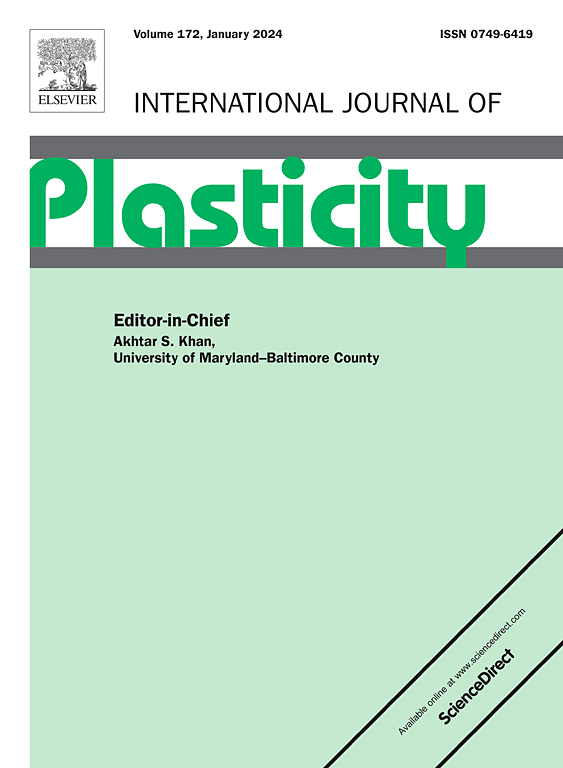A variational framework for Cahn–Hilliard-type diffusion coupled with Allen–Cahn-type multi-phase transformations in elastic and dissipative solids
IF 12.8
1区 材料科学
Q1 ENGINEERING, MECHANICAL
引用次数: 0
Abstract
This article presents a variational framework for coupled chemo-mechanical solids undergoing irreversible micro-structural changes at infinitesimal strains. The coupled problem is characterised by phenomena such as phase transitions, micro-structure coarsening and swelling. It is an extension of our previous work on variational inelasticity for a conserved chemo-mechanical setting to a unified conserved and non-conserved setting which include multi-phase transformations. The variational framework, again governed by continuous-time, discrete-time and discrete-space–time incremental variational principles, is outlined for coupled diffusion-phase transformation phenomena in elastic and dissipative solids. For the sake of simplicity, focus is restricted to isothermal conditions. It is shown that the governing macro- and micro-balance equations of the coupled problem appear as Euler equations of these minimisation and saddle point principles. In contrast to our previous work, extended variational principles (with the gradient of the chemical potential and phase fractions) are constructed that account for diffusion-phase transformation coupling. This is achieved by Legendre transformations. Note that the local–global solution strategy is still preserved and the resulting system of symmetric non-linear algebraic equations are solved by Newton–Raphson-type iterative methods. The applicability of the proposed framework is demonstrated by numerical simulations that qualitatively characterise lower bainitic micro-structure.
弹性和耗散固体中卡恩-希利亚德型扩散与艾伦-卡恩型多相转变的变分框架
本文提出了一个变分框架,用于研究在无穷小应变下发生不可逆微观结构变化的耦合化学机械固体。耦合问题的特征是相变、微结构粗化和膨胀等现象。它是我们之前针对化学机械守恒设置的变分非弹性问题所做工作的延伸,将守恒和非守恒设置统一起来,其中包括多相转变。变分框架同样受连续-时间、离散-时间和离散-时空增量变分原理的支配,概述了弹性和耗散固体中的耦合扩散-相变现象。为简单起见,重点仅限于等温条件。研究表明,耦合问题的宏观和微观平衡方程是作为这些最小化和鞍点原理的欧拉方程出现的。与我们之前的工作不同的是,我们构建了扩展的变分原理(具有化学势梯度和相分数),其中考虑到了扩散和相变耦合。这是通过 Legendre 变换实现的。需要注意的是,仍然保留了局部-全局求解策略,由此产生的对称非线性代数方程系统采用牛顿-拉斐尔迭代法求解。通过数值模拟对下贝氏体微观结构进行定性分析,证明了所提框架的适用性。
本文章由计算机程序翻译,如有差异,请以英文原文为准。
求助全文
约1分钟内获得全文
求助全文
来源期刊

International Journal of Plasticity
工程技术-材料科学:综合
CiteScore
15.30
自引率
26.50%
发文量
256
审稿时长
46 days
期刊介绍:
International Journal of Plasticity aims to present original research encompassing all facets of plastic deformation, damage, and fracture behavior in both isotropic and anisotropic solids. This includes exploring the thermodynamics of plasticity and fracture, continuum theory, and macroscopic as well as microscopic phenomena.
Topics of interest span the plastic behavior of single crystals and polycrystalline metals, ceramics, rocks, soils, composites, nanocrystalline and microelectronics materials, shape memory alloys, ferroelectric ceramics, thin films, and polymers. Additionally, the journal covers plasticity aspects of failure and fracture mechanics. Contributions involving significant experimental, numerical, or theoretical advancements that enhance the understanding of the plastic behavior of solids are particularly valued. Papers addressing the modeling of finite nonlinear elastic deformation, bearing similarities to the modeling of plastic deformation, are also welcomed.
 求助内容:
求助内容: 应助结果提醒方式:
应助结果提醒方式:


